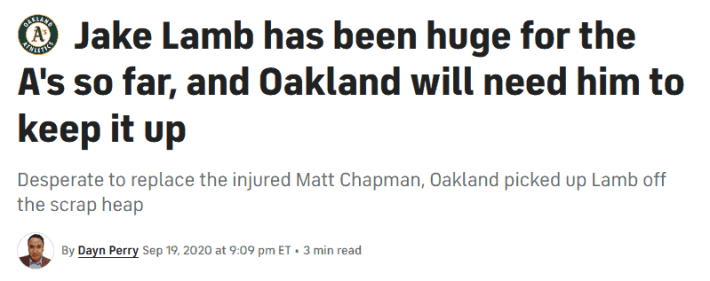The White Sox crossed the halfway point toward the trade deadline this week, and Jake Lamb is here to say that the left-handed bat you've been pining for has been with you the whole time. You just had to see him with clear eyes and a full heart.
OK, maybe don't watch him roam right field with such investment, but he deserves your attention in the batter's box, where he's hitting .261/.404/.478 over 57 plate appearances.
Sure, it has many of the markings of a fluke. He rolled into town with a .205/.309/.351 average over the previous three seasons, most of which were spent with the Diamondbacks, and he lost a competition for a job with the Braves during spring training. Now he's joining the White Sox's Walkathon and lighting up even strong right-handed pitchers, despite having no history of typical platoon splits the last three years. It's all a little much.
If you're looking to beef up his sample, this run is adjacent to a similar revival with Oakland last year, during which he hit .267/.327/.556 over 49 plate appearances for the A's. Smash those samples together, and you have a guy hitting .264/.368/.516 across a total of plate appearances that reaches triple digits (108 PA). Yet it doesn't seem like it's that simple, or else Oakland probably would have stuck with him, some team would have signed him before late February, and Atlanta wouldn't have cut him in late March.
He said last September he made tweaks between leaving Arizona and debuting for Oakland, and sure, he closed his stance a little, and maybe that helped. But as Dayn Perry noted during the encouraging early returns, Lamb's wOBA with the Diamondbacks (.261) was 80 points lower than his expected wOBA (.340), which would be above average. Some of luck was due to even out, and by the end of the 60-game season, his luck had evened out in a couple of columns:
- 2019: .193/.323/.353
- 2020: .193/.283/.352
Teams better at identifying affordable hitting talent passed on Lamb, so the context doesn't paint the picture of a guy on the cusp of a breakout. So when I started writing this post, I merely intended to use Lamb as the latest guy who's helping the White Sox cross off a week at a time while the front office waits for the trade market to materialize, after which I would list some possible targets. In fact, I was basically going to rip off the headline on Perry's piece, because the Sox are in the exact same situation as Oakland last year:

But in the process of checking whether Lamb's approach resembles his Oakland form more than what he was doing in Arizona, I found out that Lamb's recent Chicago self doesn't resemble Lamb's early Chicago self.
* * * * * * * * *
Lamb has made a pretty significant in-season adjustment to the way he goes about his business in the batter's box, and let's see if you can spot it. Here's Lamb facing Shane Bieber all the way back on April 13, a game where he went 0-for-4 with two strikeouts. A lot of guys go 0-for-4 against Bieber, but that's not the point here. Just put on your best anonymous "American League scout" glasses and take a look.
Ready? Here's the before:

Now, here's Lamb facing Bieber on Tuesday, a game where he reached base all four times. If you don't want me to spoil it, wait until you're ready to scroll past this GIF.

Notice the difference? Besides the outcomes?
Lamb swapped out his leg kick for a toe tap. Maybe it's not even a "tap" since his foot often doesn't come back up, but "dainty stride" probably isn't used in scouting reports, so we'll use "toe tap" for a toe-oriented foot placement for the purposes of this post.
Lots of guys make changes to their stance over the course of the season based on how they're feeling and what pitches they might be getting abused by, and oftentimes it's incidental to the results. What's notable about Lamb's changes is not that they exist, but when he made them.
Let's go back to the White Sox-Twins game on May 13, when Lamb gets the start against Minnesota righty Michael Pineda. In his first at-bat in the first inning, Pineda strikes out Lamb on three pitches, with Lamb using the leg kick each time.
Lamb next comes to the plate in the third. He uses the leg kick through the first three pitches, including this breaking ball on a 1-1 count on which Lamb can't check his swing.

Pineda tries the same pitch on 1-2, but Lamb lays off it, and without any stride whatsoever.

One pitch later, Pineda comes back with a fastball, and Lamb lasers it out to right without even picking up his front foot, stunning Pineda in the process.
Lamb then chooses to go strideless for the entirety of his next at-bat, although he doesn't have same success. He walks back to the dugout with a backwards K after Pineda clips the bottom of the zone with a slider.
Lamb didn't see further action until four days later, and when he comes back, he's split the difference between the two forms he showed in that game against the Twins. He's got this toe tap, and he uses it on the first pitch he sees on May 17, lining out to center.
And that's more or less what he's been doing ever since, and to fantastic results. Lamb has reached base 12 times over his last seven starts, but even if you set the outcomes aside, he's faring vastly differently at the component level. He's chasing fewer pitches out of the zone, he's making a little more contact, and the pitches he's putting into play are getting off the ground.
| Date | PA | BA | OBP | SLG | Contact% | GB% | Chase% |
|---|---|---|---|---|---|---|---|
| Through 5/13 | 31 | .167 | .355 | .292 | 76.9 | 64.3 | 30.0 |
| After 5/13 | 26 | .364 | .462 | .682 | 80.0 | 23.5 | 21.3 |
And the gap in these numbers would be even more severe if you shifted the home run he hit from the top row to the bottom row, which could then be classified as "leg kick" and "no leg kick."
There is a little bit of noise, in that the "after 5/13" row represents regular playing time that he hadn't enjoyed during April. He didn't even start consecutive games over the first month. At best, he appeared in three games over five days. At worst, he dropped off the lineup card for a week afterward. There just wasn't a reason to play him with regards to his performance or his position, and so there wasn't much reason to ponder his plight.
Lamb has fashioned himself into enough of an outfielder to find time now, whether he's letting Adam Eaton rest his legs in right, or sparing Andrew Vaughn a difficult assignment against a righty in left. Perhaps if Eaton started ailing in April, Lamb would have found this kind of groove without changing anything he did in the box. We're only talking about a couple dozen plate appearances, so it could be a short-lived resurgence at a time that benefits the White Sox immensely.
Still, it's worth exploring further, because Yermín Mercedes is hitless in his last 19 at-bats, and he slugged .313 against righties in May. He might be the one who requires a caddy now, so the Sox may as well see how far Lamb's resurgence goes by letting him soak up some time at DH. If the Sox run Lamb into the ground (send him to the slaughter?), it will confirm where Rick Hahn needs to direct some resources as the trade deadline draws nearer. If Lamb somehow rediscovered the All-Star-caliber offense he posted for two years in Arizona after years wandering deserts literal and figurative, the Sox's shopping list might be one item shorter.
You seldom see a player make a change so abruptly, and it seldom generates such stark changes in results, so it's fun to imagine a story where Lamb uses a gentle toe placement to pivot back to stardom. I'm not ready to rush to that conclusion, but the nice thing about early June is that there's no need to get it right immediately. Everybody involved can just let it play out by playing him.
(Photo by Bruce Kluckhohn / USA TODAY Sports)





